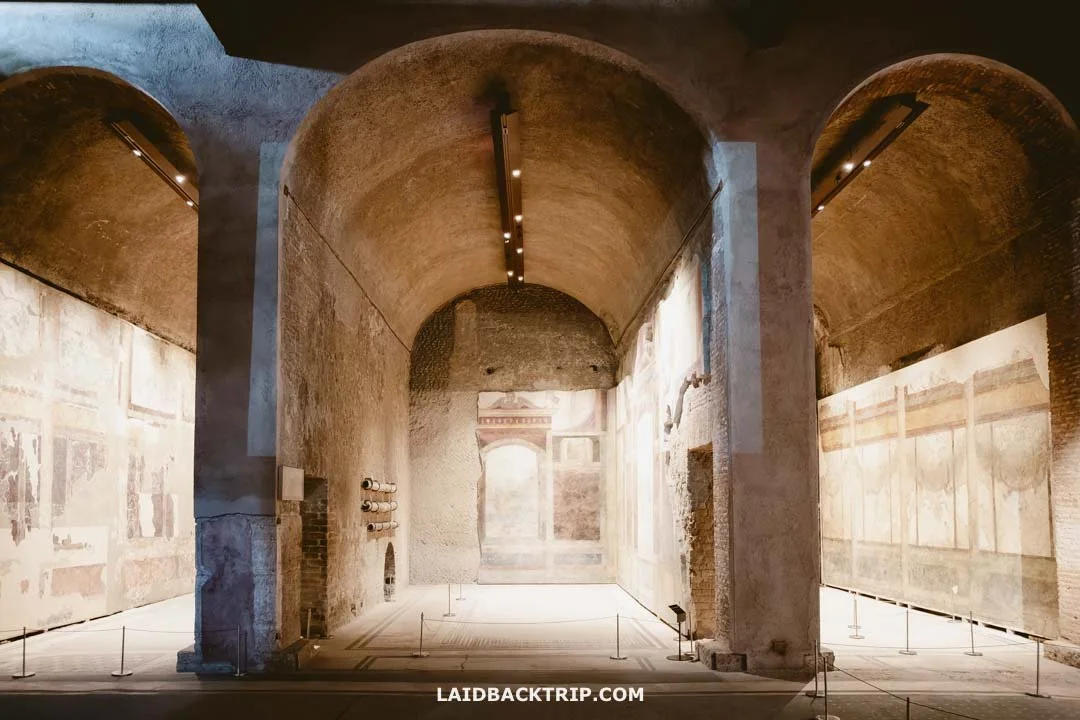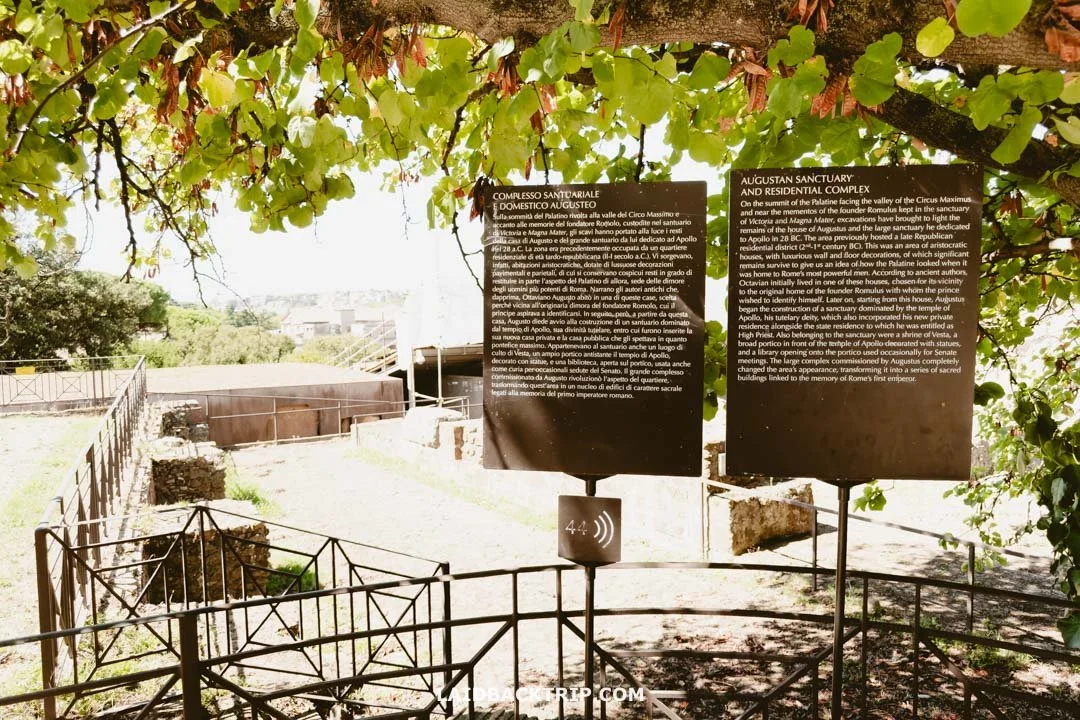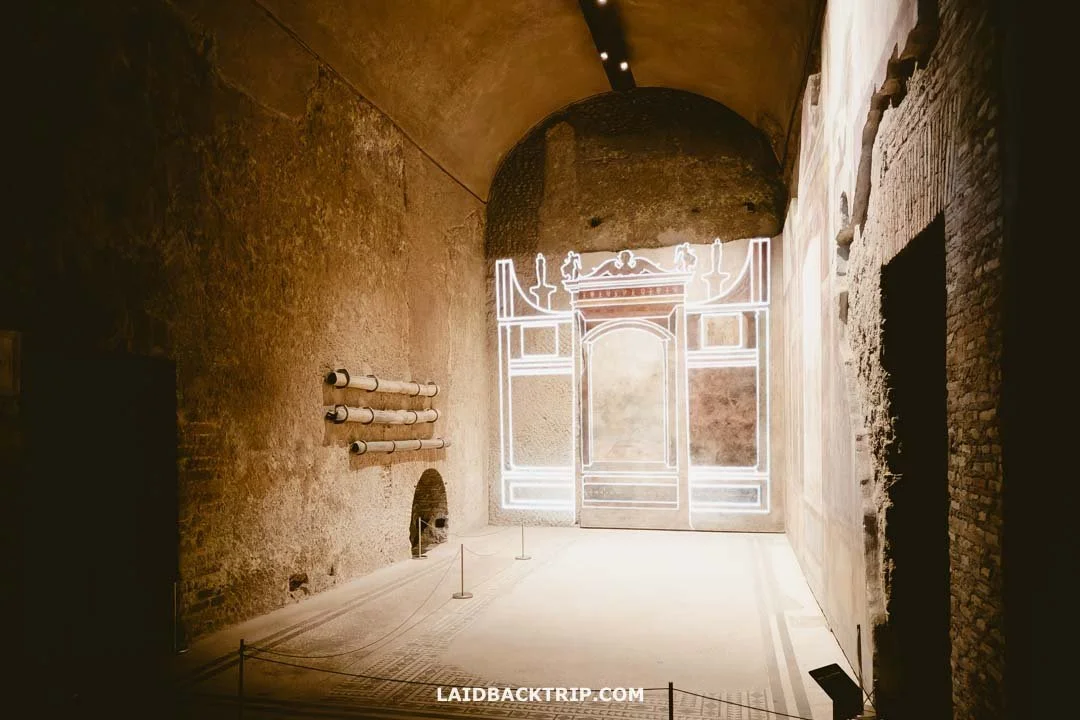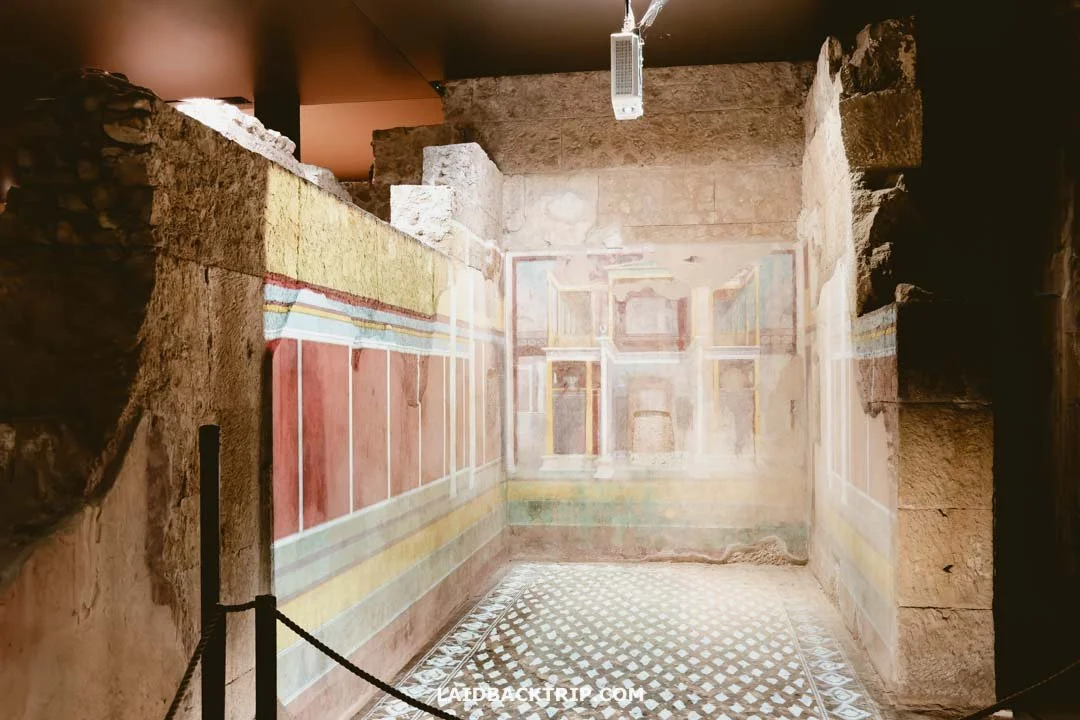How to Visit the Houses of Augustus and Livia (Palatine Hill)
The House of Augustus was built on the Palatine Hill after 36 BCE.
Follow Lucie and me on our visit to the House of Augustus and the House of Livia on Palatine Hill.
Looking back, the House of Augustus and the House of Livia ended up being the highlights of our visit to Palatine Hill. We admittedly came to Palatine Hill, the oldest part of Rome, a bit unprepared. As a result, we nearly missed both houses since we hadn't planned ahead. Luckily, things worked out, and we got to enjoy some of the most fascinating spots Palatine Hill had to offer.
Basically, the House of Augustus served as Emperor Augustus's private home, while the House of Livia was where his wife, Livia Drusilla, lived. Both houses were quite simple in size but filled with stunning frescoes, paintings, and mosaic floors dating back to 30 BCE.
While the Roman Forum and Palatine Hill were packed with incredible ruins, these were among the few spots where we could actually see 2000-year-old Roman paintings. In fact, they were some of the best-preserved examples of Roman Second Style art in the whole complex. Funnily, we only learned all this after exploring both houses, as we had no clue what to expect before going in.
Even though the House of Augustus and the House of Livia are technically separate sites, we explored them together. They fit together perfectly, which is why we put together this guide for both. Let's jump right in!
Both the House of Augustus and the House of Livia featured remarkable Roman frescoes and paintings.
Getting to the House of Augustus and the House of Livia
Since the House of Augustus and the House of Livia were located on Palatine Hill, right in its southwestern corner, it took us a bit of time to reach them. Because both sites are part of the Roman Forum and Palatine Hill archaeological park, the only way to get there was by walking. As we were in a major attraction in central Rome, the whole area was well connected by metro, buses, and trams (for example, Colosseo station has all three).
Since we stayed at Hotel Navona, we got into the complex through the Imperial Forum, located almost on the opposite end, and exited via the Via Sacra. Both spots work well for entering or leaving the complex, though the closest access point to the House of Augustus and the House of Livia is Portale del Vignola on Via di S. Gregorio.
Tickets to the House of Augustus and Livia
One of the key things we learned about the House of Augustus and the House of Livia was related to the tickets. We discovered that to visit both sites, we needed the ticket that included the Super Sites. Although we only had a vague idea of what these Super Sites were, we decided to give them a shot. Luckily, that ticket gave us access to both the House of Augustus and Livia, which was awesome. Things get a bit tricky here, so let's look at the details more closely.
Even the entrance to Livia's House had frescoes.
We already knew both houses were part of the Roman Forum and Palatine Hill complex, which, as we soon learned, offered different kinds of tickets. Lucie was quite set on getting the one that included the Super Sites, so that's the one we chose. The key thing was that this archaeological park also covered the nearby Colosseum and, as a result, offered cheaper combo tickets (called Full Experience Tickets) that included both spots.
Entry Fee to the House of Augustus and the House of Livia
To visit the House of Augustus and the House of Livia, we bought the Full Experience Ticket with Entry to the Arena of the Colosseum and Super Sites for €24. There were a few other versions of these tickets that gave access to different parts of the Colosseum, but they were sold out, so we chose this one. Still, this post isn't really about the Colosseum, but about the House of Augustus and the House of Livia, so for this guide, we'll just say you need the ticket that includes the Super Sites.
The House of Livia was all about these three fresco-filled rooms.
By the way, apart from the different Colosseum tickets, there was also one called Forum Pass Super for €18, but it only included the Roman Forum and Palatine Hill, not the Colosseum, so we ruled it out quickly.
Unlike the Colosseum or the Borghese Gallery, there were no timed tickets for the House of Augustus and the House of Livia that could be reserved ahead, only timed entries when visitors were allowed in. You can also visit both houses with a private guide if you want to learn more beyoned the audio guide explanation.
Visiting the House of Augustus and the House of Livia
After spending a few hours exploring the Roman Forum, we finally made our way up to Palatine Hill. Along with the main ruins like Domus Flavia (Flavian Palace) and the Palatine Stadium (called Hippodromus Palatii; by the way, he also built Stadium of Domitian on Piazza Navona), we wanted to see the House of Augustus because it was said to be the home of the first, and one of the greatest, Roman emperors.
To be honest, we had no idea what this residence would look like or what we might find inside. We weren't even sure if it was still standing, since so many ancient structures around us had turned into ruins over the centuries. But because it was listed as one of the Super Sites, we figured there must be something special about it.
The House of Augustus was the residence of the first Roman emperor.
Because we arrived from the Roman Forum, the first site we came across was the House of Livia. Still, we walked past it without paying much attention, since from the outside it didn't appear too exciting. It looked partially rebuilt, and we figured it probably housed items uncovered during digs on Palatine Hill.
The main reason we didn't linger at the House of Livia was that we were running short on time. We had visited the Imperial and Roman Forums first and saved Palatine Hill for the end, and with a timed Colosseum entry coming up, we had to start being a little more selective about what to explore.
We then made our way to the House of Augustus, located a little farther along the path. The signs in this part of the site weren't great, and though we didn't exactly get lost, we did take the wrong path and missed it. We ended up at what we thought was the House of Augustus, but it was actually Casa Romuli, the supposed home of Romulus, the founder of Rome.
This was the spot where Romulus's hut once stood.
We wandered around the sheltered ruin before realizing we hadn't actually found the House of Augustus. There was one trail leading down the slope, but it didn't seem like the right one, so we turned back, only to realize that doing so meant we'd miss the House of Augustus entirely.
We returned to the little intersection we had ignored before and finally decided to follow it. It took us directly to the entrance of the House of Augustus. There, at the metal gate, a staff member stopped us, explaining that we couldn't go in just yet since another group was currently inside.
This is the entrance to the House of Augustus.
At that point, we found out that access to the House of Augustus was only allowed with a guide. Thankfully, the guide was one of the staff members, so no booking was required. She explained that the next English tour would begin in about 30 minutes, but that the House of Livia's English tour was starting at 11 AM, which was right then.
She told us that if we moved fast, we might catch it in time. That left us with a quick choice to make. We could wait 30 minutes for this tour, try to catch the House of Livia tour starting now, or forget about both and continue exploring Palatine Hill.
House of Livia (Casa di Livia)
Because that was why we came in the first place, we chose to go back to the House of Livia and visit it first, then return to the House of Augustus afterward. A bit worried we'd be too late, we rushed over to the House of Livia. Since the two houses were so close together, the walk took less than two minutes. By the time we got there, the group had already gone inside, but luckily, the staff let us join them.
We visited the House of Livia as part of a guided tour.
Once we caught our breath, we walked down the stairs further inside the house. Within a few seconds, we reached the group in what looked like a nearly pitch-dark room, with just one spot lit. We waited as our eyes adjusted to the darkness and the lighted section ahead, listening to the English narration. After a short while, we realized it was just an audio guide, but at least it was easy to understand.
So this was Livia Drusilla's home, who married Augustus after divorcing Tiberius Claudius Nero. In addition to the main atrium with four tall pillars holding up the ceiling, four other rooms had survived for more than 2000 years. Each room was connected to the atrium, so we remained in that space the whole time. The commentary covered one room at a time, and we were able to move a little closer for each.
We got to see the frescoes in each room up close.
The most interesting part was the light mapping, which projected light directly onto the frescoes and described what we were seeing. It wasn't only a neat effect but also a clever way to bring out every detail and fill in the lost sections of the 2000-year-old paintings. The light mapping also made it clear why the room itself had to stay dark.
So the true highlight of the House of Livia wasn't the building, but the colorful frescoes of gardens and mythological scenes decorating its walls. Since the house dated back to the 1st century BCE, it was truly incredible to see how much of it still remained.
Lighting effects and video projections were big part of the House of Livia tour.
Speaking of Roman paintings, we later discovered another place with a similar name: the Villa of Livia, an ancient Roman villa a few kilometers north of Rome. We only learned about it a few days later when visiting the Palazzo Massimo Museum, which displays the beautiful garden frescoes that were moved there from that villa.
The visit lasted roughly 20 minutes, and afterward, the lights turned on, revealing the space as it would normally appear. We stayed for a bit to take some photos before heading back to the entrance. With the House of Livia done, we still had the House of Augustus to see, so we set off that way with a few people from our group.
House of Livia Opening Hours
When we visited in early September, technically still the summer season, the House of Livia was open from 9:30 AM to 6 PM, with the last entry allowed 30 minutes before closing. It stayed closed on Tuesdays and on free admission days. Independent visits were available at 9:30 AM, 10 AM, 12:30 PM, 1 PM, 1:30 PM, 2 PM, 4:30 PM, 5 PM, and 5:30 PM.
Here are the opening times for the House of Livia.
We arrived just in time to join the first English Multimedia Tour at 11 AM. The following ones were scheduled for 12 PM, 3 PM, and 4 PM. There were also Italian versions of the same tour that started 30 minutes earlier. I'm mentioning the Italian tours in case you miss an English one, since you can still view the frescoes. Unless you understand Italian, the commentary won't be too helpful, though.
House of Augustus (Casa di Augusto)
Since the houses were basically right next to each other, we reached the House of Augustus a few minutes early, before the guide let us inside. Once we entered, she drew the curtains, and the tour began with a short video presentation about the house and Augustus.
The tour at Augustus's house started with a short movie.
Augustus was the founder of the Roman Empire, which also made him the first Roman emperor. He ruled from 27 BCE to 14 CE and chose this location for one simple reason. It was the home of the legendary Romulus, the founder of Rome! That's why he decided to live on Palatine Hill. In the centuries that followed, other emperors continued the tradition and built their own palaces here. Since Augustus was the first, his palace was the most modest of all.
After the video ended, the guide led us around this section of the house, stopping at marked spots with additional light mapping. It was really well done and quite similar to what we saw in the House of Livia. Again, the pre-recorded narration explained what we were looking at, while the lights highlighted key details and occasionally reconstructed whole paintings. There were even cool touches, like lasers tracing the floor decorations.
Light mapping was part of the experience at Augustus's house too.
Once again, the whole experience was set up so everyone had to stay with the group and follow the marked route. We had a guide with us mainly to keep us together, since the commentary was pre-recorded and part of the light show. That meant we couldn't explore the house on our own, but it wasn't a big deal. The group was pretty small, which helped because the path was narrow and the space in front of each room was limited, so we could see everything clearly during the laser show.
These rooms were once the private living quarters of Augustus.
The House of Augustus was modest compared to later imperial palaces, but that didn't make it any less important. We learned that despite Augustus' great power, his private home reflected his wish to appear humble. Later during our trip, we visited the lovely town of Tivoli, home to two UNESCO sites. One was Hadrian's Villa, Emperor Hadrian's private retreat. While it was also a residence, it felt like an entire city. It was huge compared to this simple house. Details like these, showing how each emperor had a different vision, made history feel even more fascinating to us.
From outside, there really wasn't much to see at the House of Augustus.
Leaving this section of the palace, which was now a big sheltered hall showing the outlines of old rooms, we walked to the next area. This section included the well-known Room of the Masks, decorated with stunning Second Style frescoes of theater masks, Room of the Pine Festoons, intricate architecture and more light mapping. It also marked the end of the tour, and once we finished exploring the rooms, we could exit on our own.
The Room of the Masks is the most famous frescoed room in the House of Augustus.
Both houses were amazing, but I personally liked the House of Augustus more because it was bigger and belonged to the first Roman emperor. Lucie preferred the House of Livia for its intimate atmosphere and, honestly, its more stunning wall paintings. If we had time for just one, I'd choose the House of Augustus, and she'd pick the House of Livia (though that wouldn't make sense since their visiting times didn't overlap anyway).
House of Augustus Opening Hours
During our visit, similar to the House of Livia, the House of Augustus was open from 9:30 AM to 6 PM, with the last entry allowed 30 minutes before closing. The only difference was that the House of Augustus closed on Mondays and on days with free admission. Independent visit slots were the same as before: 9:30 AM, 10 AM, 12:30 PM, 1 PM, 1:30 PM, 2 PM, 4:30 PM, 5 PM, and 5:30 PM.
The only change was in the Multimedia Tour schedule, which was reversed. We missed the first one that started at 10:30 AM, but made it to the second at 11:30 AM. The last two were at 2:30 PM and 3:30 PM, while the Italian tours started 30 minutes later than the English ones.
It was pretty amazing to see how many of the frescoes are still around after 2,000 years.
Travel Insurance
We never leave home without travel insurance that was designed to cover our expenses if something goes wrong during the trip. Travel insurance protects against theft, flight delays, injury, illness, cancellations, and much more. Travel smarter and safer!
World Nomads provides travel insurance for travelers to cover their trip essentials, including sports and adventure activities.
SafetyWing is affordable travel insurance for backpackers, long-term travelers, and digital nomads.
How Much Time We Spent at the Houses of Augustus and Livia
We started the tour at the House of Livia at 11 AM, and it lasted about 20 minutes. Then we walked over to the House of Augustus, where the next tour began at 11:30 AM and lasted a bit over 20 minutes. Altogether, we spent under an hour exploring both houses, though of course, you could visit just one and cut that time in half. As both houses are only accessible with a guide, these timings are more or less the same for everyone.
Inside the House of Augustus was also the Room of the Pine Festoons.
Were the Houses of Augustus and Livia Worth Seeing?
Like I said before, at first, we weren't sure whether to spend an hour touring both houses or keep wandering around Palatine Hill. But it turned out that the House of Augustus and the House of Livia became our absolute favorite places there, and we were really happy we got to see their interiors.
The narrated tours with light mapping made the Houses of Augustus and Livia even more interesting.
We didn't expect much, though, to be fair, we really had no idea what to expect. But walking through these ruins covered with such beautiful frescoes (some of the best we saw during our entire trip to Rome) was way beyond what we imagined. It was hard to wrap our heads around the idea that we were walking the same halls once used by Emperor Augustus. Even crazier was how incredibly well-preserved the paintings were after two thousand years.
After being so positive throughout this post, it's probably no surprise that, for me, the House of Augustus and the House of Livia were the best of all five Super Sites. These were the ones that really convinced me that the slightly pricier Full Experience tickets were totally worth the extra cost.
Travel Resources
Here you can find links to all the travel resources we use and which you might find helpful when planning your next holiday.
Accommodation: When looking for accommodation, we usually search hotels via Booking.com or Hostelworld.
Tours: Although we love to travel independently, some places are better to visit with a guided tour.
We prefer GetYourGuide for its easy-to-use interface and solid reputation. Another great alternative is Viator.
Rental Cars: When going on a road trip, we always use Rentalcars.com, a reliable site for booking a rental car in advance.
Flight Tickets: When looking for flight tickets, you can search Skyscanner to find the best price.
Travel Insurance: World Nomads and SafetyWing cover against risks of travel.























